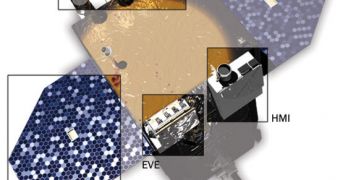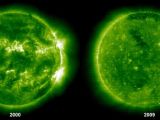Officials at NASA announce that the newest space mission developed by the agency, the Solar Dynamics Observatory (SDO), is set to launch on Tuesday, February 9, from the Cape Canaveral Air Force Station (CCAFS), in Florida. The spacecraft, which will take off no earlier than 10:30 am EST (1530 GMT), is scheduled to spend at least 5 years and three months studying the variability of the Sun, in one of the few missions the American space agency has dedicated to this purpose.
“Contrary to popular belief, the Sun is a magnetic variable star. SDO will show us just how variable the Sun really is and will reveal the underlying physics of solar variability,” says of the mission the “Living With a Star” lead program scientist, Madhulika Guhathakurta. The expert is based at the NASA Headquarters, in Washington DC. The new spacecraft will blast to orbit atop an Atlas V delivery system, and will feature three main scientific instruments, which will help it peer into the star's inner workings, and also determine its variability in the extreme ultraviolet wavelengths.
Arguably the most important tool is the Extreme Ultraviolet Variability Experiment (EVE), which will be in charge of measuring precisely how much radiant energy the Sun emits at extreme ultraviolet wavelengths. Such measurements cannot be documented from our planet because the atmosphere traps these wavelengths, and does not allow this type of light to pass. On the other hand, people living in space, such as astronauts on the International Space Station (ISS) are exposed to the effects of EUV light around the clock.
The other two instruments, the Helioseismic and Magnetic Imager (HMI) and the Atmospheric Imaging Assembly (AIA), will work together in order to create correlations between variations that occur on the Sun's surface and within the star. It will be HMI's job to create maps that will explain the plasma flows that occur underneath the solar atmosphere, as well as to determine the surface of the magnetic fields at work. AIA will, in turn, take measurements of the solar atmosphere in wavelengths that are not available from Earth.
“SDO will take full-disk, high definition images of the Sun all of the time. These advances will provide the data to better understand how the Sun works and will allow us to develop the tools to predict its behavior,” concludes Liz Citrin, who is the SDO project manager at the NASA Goddard Space Flight Center, in Greenbelt, Maryland. He goes on to say that no other mission before the SDO had the technical capabilities to snap images at such fast cadences. In addition, the spacecraft will have the bandwidth required to send all these datasets back to Earth, for processing.

 14 DAY TRIAL //
14 DAY TRIAL // 

